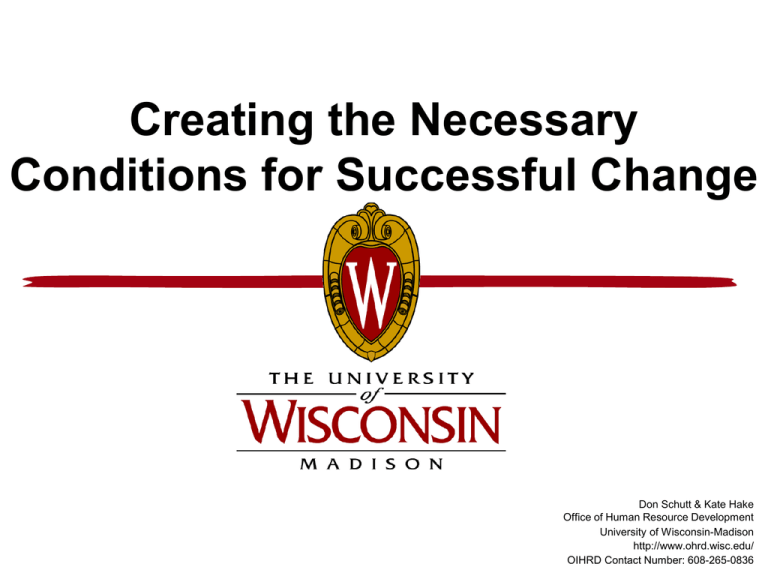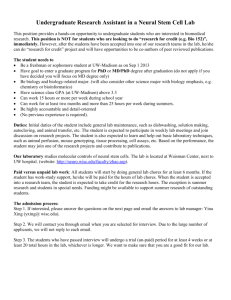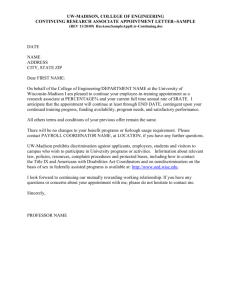Engagement - Wisconsin IPMA-HR
advertisement

Creating the Necessary Conditions for Successful Change Don Schutt & Kate Hake Office of Human Resource Development University of Wisconsin-Madison http://www.ohrd.wisc.edu/ OIHRD Contact Number: 608-265-0836 Description Change is happening all around us, all the time. How you prepare for continuous change on both the individual and the organizational levels can help to focus on the opportunities embedded in change, and lead to a culture where change is accepted as ongoing and valuable. Come learn about how you can create the necessary conditions for change in your unit. Agenda A Personal Connection… Changing Change The Big Five Closing Notes Thanks! A Thoughtful Moment When I am faced with change, I am likely to… When I am having these reactions, I cope with them by doing the following positive or negative behaviors… Necessary Conditions Changes, even ones we want, even good ones, send us through a process of readjustment and on a very basic level. Anything that affects our sense of our own identities, stature, self-image... -- Dan Oestrich, Leadership Consultant/Author, Redmond, WA Necessary Conditions Unless people have a reason for changing, they will not do so – the day-to-day will win out over the change. -- Drumm McNaughton, President, “The Change Leader” Fallbrook, CA Some Notes Assumptions, beliefs and reflex reactions about change directly impact your ability to lead, perceive, and facilitate change effectively All reactions to change are legitimate and need to be aired; resistance can grow out of repressed or unaired reactions Developing effective change management skills and attitudes is essential to dealing with increasing complexities of the environment Managing Complex Change, 1989, Being First Inc. The Question What are the necessary conditions that need to exist in an organization in order for change to occur? Necessary Conditions In nature change is a function of creative mutation -- DNA changes because of accidents that are advantageous to the organism. So perhaps creative change is learning to make opportunities out of perceived mistakes. Also, it occurs that any addictive behavior stays in place until or unless the consequences of not changing are worse than the fear of change. -- Ben Sidran, Jazz Musician Changing Change The Big Five (Our First List) 1. 2. 3. 4. 5. Positive self-efficacy Hope Integrity Vision Leadership The Question What are the necessary conditions that need to exist in an organization in order for change to occur? The Big Five Necessary Conditions 1. 2. 3. 4. 5. Engagement Trust Vision Risk Leadership The Big Five Engagement Engagement that leads to building strong relationships would seem to be the goal. It can be achieved through open, public, dialogue and transparent processes. The end result is stronger, honest relationships that create a culture of change. Engagement Necessary Conditions Transformation occurs in public, in assembly, in meetings, when we are reminded we are part of something larger. Small groups are the unit of transformation, questions are the means, and invitation is the strategy. Transformation occurs when the axis of accountability shifts. It occurs the moment we seek the right question. In the pursuit of the question, I become an activist citizen and an owner of the future. In seeking the right answer, I become a consumer and the effect of the actions of others. -- Peter Block, Author, Consultant and Citizen of Cincinnati, OH Engagement Necessary Conditions I think that identifying and engaging the early adopters is key to facilitating change. If you do not have these people on board with your change efforts, you are doomed for failure. The early adopters act as agents of change in the equation. ... With them onboard your work is easier as they will help drive the change past the tipping point into inevitable success. -- Ron Sober, University of Michigan Engagement Necessary Conditions The people that will be affected by the change need to be involved in the change, from the decision to implement the change all the way through the process. While this may not always be realistic, the more people can be involved, the more they will support the change. -- Jamie O’Donnell, Office of State Employee Relations, State of Wisconsin Engagement Necessary Conditions The dominant belief is that laser-like goals, better controls, clearer consequences, more inspirational leadership, and better systems will make a difference. They won’t. They are the problem, not the solution. These strategies are incapable of transformation; they just make things a little better. Engagement is more critical than sponsorship. Relationships are the ends, not the means. Private conversation, no matter how powerful, does not shift the communal possibility. -- Peter Block, Author, Consultant and Citizen of Cincinnati, OH Engagement Necessary Conditions The unit staff has to buy in. --Donna Shalala President of University of Miami, FL Engagement Necessary Conditions First, there should be as much transparency as possible in the conversation around the need for change -- underlying financial conditions, market realities, real fears and aspirations of leadership, etc. This is necessary to establish trust with the group that will need to promote the success of the change. Second, those that need to participate in the change should have as much input as possible in how they personally will ride the change -- job design, experiments with new processes and systems, and future input and feedback on how the change is going, this allows people to be the change rather than being the victim of the change. -- Greg Simmons, President & CEO, MetaStar Engagement Necessary Conditions The entire organization should be excited about the change and feel personally motivated to make it happen even if the final ideas pursued weren’t the ideas they proposed or supported. The process by which decisions are made should be crystal clear in order to cultivate the trust necessary to move through a big change. -- Wren Singer, Director, Orientation & New Student Programs, UW-Madison Engagement Necessary Conditions I think an organization needs to nurture dissent and debate -- real debate -- if change is to occur. -- Jeremi Suri, Professor, Department of History, UW-Madison, Recognized as one of “America’s Top Young Innovators” by Smithsonian Magazine Engagement Necessary Conditions Spend adequate time up front with staff creating the change. As critical as doing this though, is being transparent that the changes suggested are actually acted on. -- Mary Hoddy, Director, Staff Education & Training, Wisconsin Union, UW-Madison Engagement Necessary Conditions There are literally 100s of conditions necessary, but for me, the strongest is: Strong motivation – as Kotter said, “Create an urgency for change.” Unless people have a reason for changing, they will not do so – the day-to-day will win out over the change. --Drumm McNaughton President, Change Leaders The Big Five Trust Being honest, fair, and caring as demonstrated through consistency of behavior, keeping promises, communicating effectively, and creating a healthy and safe environment. Trust Necessary Conditions For continuous whitewater, individuals, teams, and organizations need trust. Not one-time trust to get us through the shifts, but trust as a strong "relational field" that creates a constant and firm foundation for ongoing adjustments to just about everything -- certainly the changes that most worry us because they affect our credibility, sense of competence, current relationships, and security. -- Dan Oestrich, Leadership Consultant/Author, Redmond, WA Trust Necessary Conditions My first thoughts are “trust” and “safe environment to fail if trying something different” -- Barb Hagens, Director of Curriculum (retired), School District of McFarland Trust Necessary Conditions I think the biggest overlooked factor is Trust. If a culture of mutual trust is not present – getting change to stick is a big challenge. If trust has been violated within the workplace, hidden divisions between people will persist. -- Stephanie Sobczak, Director, Quality & Improvement Systems, Physician’s Plus Insurance Corporation Trust Necessary Conditions There must be trust. There must be a track record of communication and follow through so the people believe that they are receiving complete, big picture information. Undoubtedly there will be some people who think there is some hidden agenda, but if there is a history of honest communication and follow through, this should be at a minimum. -- Jamie O’Donnell, Office of State Employee Relations, State of Wisconsin Trust Necessary Conditions Change is only possible if people are not afraid--that if something doesn't work, it is OK--nothing is permanent and you all evolve together. Change is a process, and it is not personal. People need to trust that they will not be held accountable for failure and that their opinion/input will be used to only make things better. Even if change is foisted upon you by external forces, the internal office environment has to be such that people feel supported. -- Char Tortorice, Director Emeritus, UW-Madison Trust Necessary Conditions A basic level of trust. Of course, getting even a basic level may be difficult. But it starts with the manager being honest and fair, and demonstrating, even in a small way ("How was your son's soccer game last night?") that he/she cares about the employees. -- Susan Paddock, Director, Wisconsin Certified Professional Manager Program & Professor, Governmental Affairs, UW-Madison Trust Necessary Conditions I think the real necessary condition is that people need the facts and not rhetoric. We have a tendency on this campus to sugar coat reality too much. If the facts are communicated to folks and they believe what they are being told they are then more willing to work towards a solution. -- Roger Maclean, Former Associate Dean for Executive Education, UW-Madison Trust Necessary Conditions Trust, respectful communications, employee goals and projects are in alignment with unit priorities and strategic direction, employees are valued and recognized, manager/supervisor accountable for their behavior and their behavior aligns with campus, School, College, Division strategic direction and with federal and state laws and campus policies. -- Luis Pinero, Assistant Vice Provost, Office for Equity and Diversity, UW-Madison Trust Necessary Conditions “One necessary condition that needs to exist in an organization in order for change to occur” = TRUST. Obviously, you can have change without trust -- it happens a lot (at least superficially). But if an organization wants effective, productive, positive change, if it wants the change to be embraced, then I believe it needs the commitment and support of its people -- and that requires at least a minimal level of trust. -- Sharon Mylrea, Training Director, Department of Transportation, State of Wisconsin The Big Five Vision A clear idea, concept or story that can be easily described and understood in a few words. “One picture says it all.” Vision Necessary Conditions I think that the condition that most allowed for change to occur in our organization was vision from the top. (Our new CIO) came in with ideas about how to deliver better services. That’s what pushed it…. -- Emily Karakashian, HR Manager, Central IT division at UC Berkeley Vision Necessary Conditions Effective leadership is the key – a couple of points about that. You have to have a vision so that people know that the change is leading to something. I would also add that there needs to be trust in leadership. -- Paul Evans, Director, Division of University Housing, UW-Madison Vision Necessary Conditions A sense of urgency--a compelling need or desire for change. It must be clear why change is required. This may be an internal desire (more altruistic) or an external response (fear of consequences or simply a realization that change is inevitable). It does not matter which. -- Kent Lesandrini, Consultant, Lesandrini & Associates, Madison, WI Vision Necessary Conditions The goal is to get everybody on board and believing in the same simple goal. For instance, Fit Fuel wanted to be "the best healthy living e-commerce store", but nobody knew what that meant. Once we clarified that goal and said "we want to be the healthy living company with the most personality and best customer service", everyone knew what they had to do to make that happen. -- Luke Burgis, CEO, FitFuel, fitfuel.com Vision Necessary Conditions Condition for change: Changing customer expectations … External demands often create internal expectations that cause people to change. --David Ulrich, Business Author Vision Necessary Conditions A very clear image of what the change can/should look like--that is, what will life be like if the change is successful? The "leader" or "champion" needs to use that as a touchstone at times to re-energize others when roadblocks appear, when energy flags, when people need to be reminded that small details can (and should change) while the basic core image remains. The image also needs to be clear and compelling enough (and simple enough) so that others can pick it up and themselves use it to motivate themselves and others. -- Aaron Brower, Vice Provost for Teaching & Learning; Professor, Department of Social Work, UW-Madison Vision Necessary Conditions Clear VISION. And upholding (stating, restating, speaking-both formally and informally, at all levels, writing, posting, etc.) the vision throughout the change process. -- Linda McNeel, Consultant, Madison, WI Vision Necessary Conditions There needs to be a vision for the change and there needs to be clearly communicate reason for the change. There needs to a clear plan of how the change will occur and the plan needs to be communicated to everyone. -- Fran Breit, Center on Education & Work, UW-Madison The Big Five Risk Balancing what there is to gain against what might be lost in an effort to continuously challenge the status quo and ask, “what have we not tried?” Risk Necessary Conditions The capacity to look beyond your present paradigm and accept that there may be dramatically different ways of solving the problems change presents -- Joel Barker, “The Paradigm Man,” Independent Scholar & Futurist Risk Necessary Conditions Clarity that the status quo will not be the future if one refuses to change. People often think if they refuse change, they are choosing the status quo. That is often not the case, but this is not clear to them. What is the default future we are choosing by NOT changing? Once that becomes clear, sometimes change seems to have a different calculus. -- Kent Lesandrini, Consultant, Lesandrini & Associates, Madison, WI Risk Necessary Conditions Risk. The necessary condition is that taking risks is valued. Results are too, but at the start, when some decisions are made, we don't know about results, only the risk that we might fail. The 'safety net' is that we need to be fairly good at recognizing when the risk we have taken isn't working out so we can reexamine and choose a different course. Still, some risks simply will not work out. I think we need to allow for those and maybe even praise them as a small price to pay for the many more risks that pay off in big ways--if we take them . -- Pat Farrell, Provost, UW-Madison Risk Necessary Conditions The organization has to want to change, which I do believe is the basic condition. I would also say a culture of risk taking and a tolerance for failure. Finally, I would say an instigator (person) or an impetus (situation) that stimulates/provokes the change. -- Laurie Beth Clark, Former Vice Provost for Faculty & Staff Programs UW-Madison Risk Necessary Conditions Transformation is the inversion of where cause resides. It is in contrast to conventional wisdom. We try on for its usefulness the ideas that: - Employees create bosses - Listening creates speaking - Problem solving exists to build relationships - The present is dictated by the future, not the past - Students create teachers -- Peter Block, Author, Consultant and Citizen of Cincinnati, OH The Big Five Leadership The sum of the previous conditions with the addition of support, commitment, and ability to model the change. Leadership Necessary Conditions Ability of leaders to embrace various perspectives and view situations through multiple lenses -- Heidi Barta Organizational Development Manager University of Washington Technology Leadership Necessary Conditions Effective leadership is the key – a couple of points about that. You have to have a vision so that people know that the change is leading to something. I would also add that there needs to be trust in leadership. -- Paul Evans, Director, Division of University Housing, UW-Madison Leadership Necessary Conditions I believe for any kind of organizational change, a clear commitment to communication is the key. --Ellie Monaco, UCLA Leadership Necessary Conditions People see through handy goals. They sense a leader's authenticity when an intellectual agenda aligns with behaviours, actions and emotional content. --David Ulrich, Professor, Business Administration, University of Michigan; also named by Business Week as one of the world’s top 10 educators in management and the top educator in human resources Leadership Necessary Conditions I would say that one necessary condition for change to occur is the presence of a change steward. Since change does not happen over night, I think the change agent (leader) needs to patient, persistent, and reflective keeping an eye on the prize within a zone of tolerable flexibility. -- Mark Isenberg, Wisconsin Department of Veterans Affairs, State of Wisconsin Leadership Necessary Conditions Change is always difficult. People are always reluctant with the uncertainty of change. To make change work, you must have strong leadership, confidence in the leadership, and great communication with those involved. -- Barry Alvarez, Athletic Director, UW-Madison The Big Five Necessary Conditions 1. 2. 3. 4. 5. Engagement Trust Vision Risk Leadership So What? Emergent changeforward-looking organization Organizational components needed for a change ready culture Structure Processes and procedures Measurements Organizational context Steps that should be ongoing Developing trust, engagement, valuing risk Systems paying attention to ongoing change Hierarchy and role Purpose and meaning Closing Notes Necessary Conditions Sustained change may begin with actions, checklists and tools, but it must evolve to the point where we adopt a fundamentally different identity. --David Ulrich, Professor, Business Administration, University of Michigan; also named by Business Week as one of the world’s top 10 educators in management and the top educator in human resources Necessary Conditions We agree to stay together through the process and not descend into blame or scapegoating, or walk away when things get tough. --Margaret Wheatley, Author “Leadership & the New Science” What Matters? Work culture & climate Work environment Relationships Healthy dialogue & respect Realizing change as a norm Necessary Conditions Change can’t occur until there is a healthy company culture in place where the people think “team” first. It's very hard for an individual or a group of individuals to effect change, especially in larger companies. -- Luke Burgis, CEO, FitFuel, fitfuel.com The Climate I Create 1. How can people expect to be treated when they approach me? 2. Do I introduce myself to new people or do anything to welcome newcomers? 3. What do I do to create a more positive climate? Necessary Conditions An affirming, respectful environment that supports individuals in their explorations of what possible changes might mean in their lives, including their own demons and fears about what they perceive it to mean. The more that environment is in place, the better as a pre-condition. -- Harry Webne-Behrman, Office of Human Resource Development, UW-Madison Necessary Conditions The QxA=E (quality solution, acceptance from the group, effective result) formula because it's simple and shows that the technical piece is only a piece to the end result and it takes change acceptance for real results. -- Scott Converse, Executive Education, UW-Madison Necessary Conditions Under what conditions are people willing to challenge status quo and assert change when they don’t have formal power? … depends first and foremost on [the] quality of immediate relationship with supervisor/manager and psychological safety of unit. -- Debra Meyerson, Author “Tempered Radicals: How People Use Differences to Inspire Change at Work” Necessary Conditions It is easier to move towards healthy change if the community starts as one with the ability to conduct healthy dialog. Where there is general respect for all between all, and generally attitudes of goodwill, even if they recognize they don't all agree with each others approaches or basic philosophies. their language. -- Dale Burke, Police Captain, University Police Department, UW-Madison Necessary Conditions Model adaptability/flexibility on an ongoing basis. Make change part of the norm, so people are used to it, value it, and do it themselves. If you can build a culture of everyone changing and adapting and being flexible on a daily basis, difficult change won't be quite so shocking. -- Maury Cotter, Director, Office of Quality Improvement, UW-Madison Questions? Comments? Thank for your interest and





